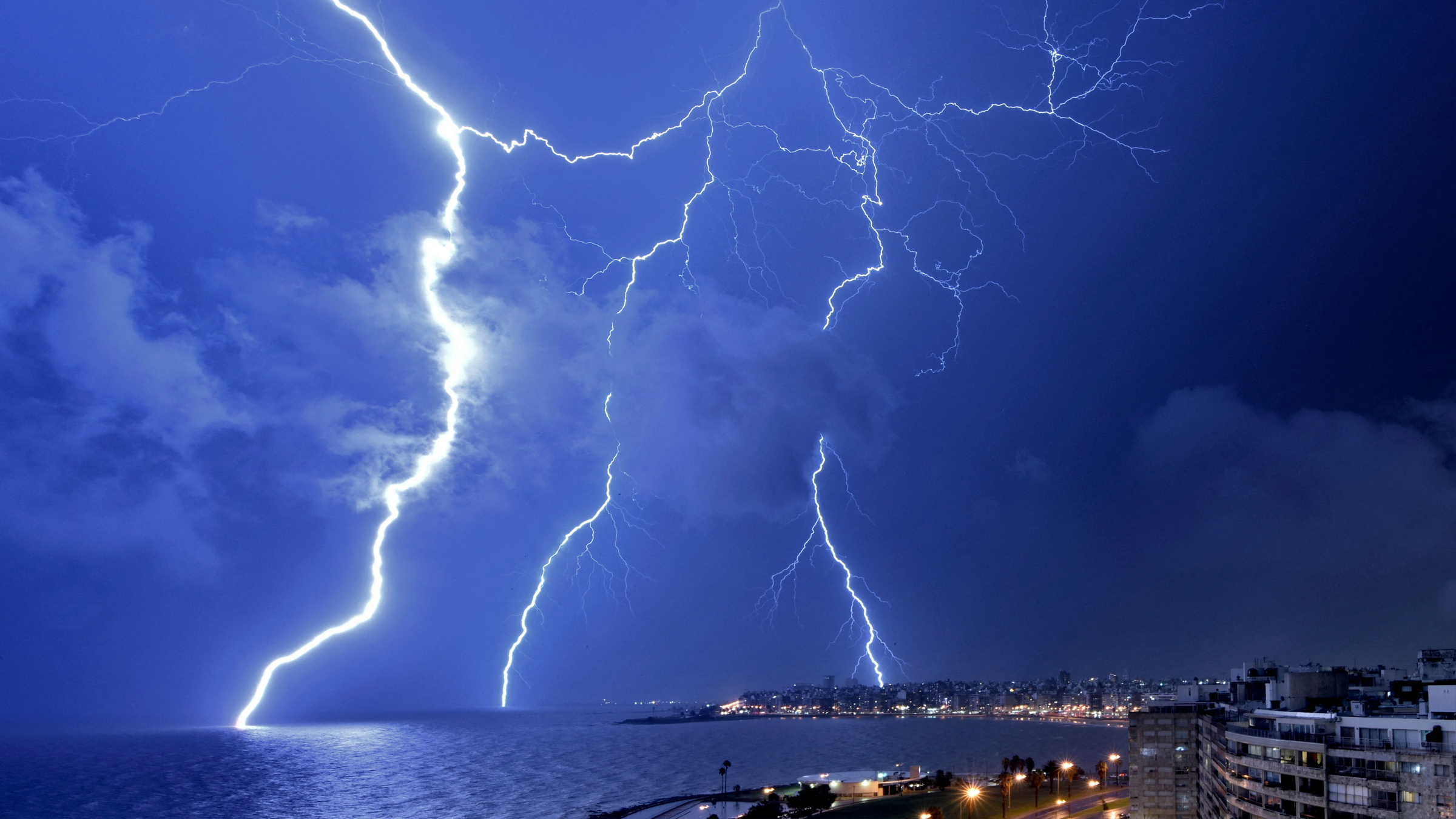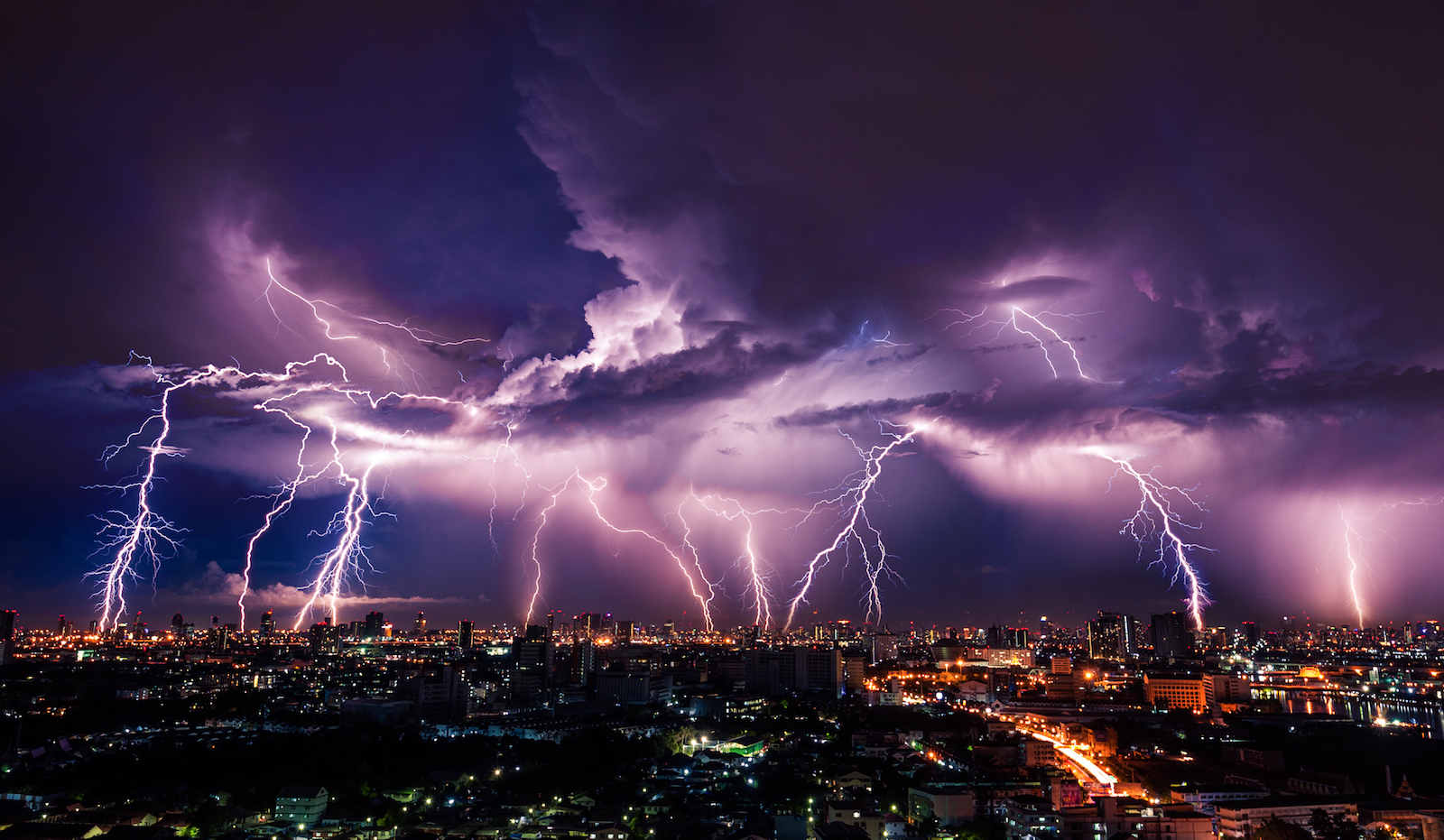What's the longest lightning bolt ever recorded?
You'll be shocked.

"Thunder is impressive," Mark Twain wrote, "but it is lightning that does the work." Anyone who's watched a lightning storm will understand what he meant: Lightning is one of nature's most awe-inspiring phenomena, illuminating the skies with its fearsome forks.
According to the U.K. Met Office, lightning strikes the planet up to 1.4 billion times a year, or an estimated 44 times every second. And it's more than just a light show: Lightning plays a critical role in keeping Earth's electrical balance in check; aids in fixing nitrogen, thereby helping plants grow; and potentially even helps to clear the atmosphere of pollutants.
But some lightning strikes work harder than others. While most lightning flashes measure 2 to 3 miles (3.2 to 4.8 kilometers) in length, some truly colossal bolts occasionally crackle above our heads, forking their way across hundreds of miles of sky. But how big can lightning actually get? And should we be worried about these gigantic bolts?
Related: Can diamonds burn?
How lightning is made
Lightning arises in storm clouds when strong positive charge develops in one region of the cloud and strong negative charge develops in another, creating electrical forces between them.
"A lightning flash is initiated in a region where the electrical forces are extremely strong," said Don MacGorman, a physicist and senior researcher at the National Oceanic and Atmospheric Administration's (NOAA) National Severe Storms Laboratory in Oklahoma. "They become strong enough that the air can't withstand the electrical force anymore and breaks down."
That means that, as the electric force grows, it breaks down the air's insulating power, which usually keeps areas of different charge separated from each other. Researchers think this occurs because the buildup of the excessive electrical force starts to accelerate "free" electrons — those not attached to an atom or a molecule — in the air, in turn knocking other electrons loose from their atoms and molecules, MacGorman said. This process continues, accelerating more and more electrons. "Scientists call this process an electron avalanche, and it's what we mean when we say the air breaks down," MacGorman told Live Science.
Get the world’s most fascinating discoveries delivered straight to your inbox.
This eventually creates a very hot channel in the air that acts like a wire, whose ends grow outward toward the positive and negative charges that caused the breakdown. The growing channel eventually connects the positive and negative charges, and when it does, it triggers the immense electric current we know as a lightning flash.
"Think of it as a giant spark that has grown through the cloud," MacGorman said.
Sometimes, the lower region of a cloud, which usually contains positive charge, does not have enough charge on its own to stop the channel. So the lightning bolt continues growing, stretching downward toward the ground. As it does so, it draws an upward spark from the ground to meet it, triggering a lightning flash with huge electric currents that transport some of the storm's charge to the ground. These cloud-to-ground channels are what most of us commonly picture when we think of lightning — those vivid forks that strike Earth.
The cloud's the limit
But what factors limit the size of these massive bolts? Researchers have been trying to answer this question for decades. Vertically, the extent of a flash is limited by the height of a storm cloud, or the distance from the ground to its pinnacle, which is about 12 miles (20 km) at its highest.
But horizontally, an extensive cloud system provides much more room to play with. This is where the heavyweights work their magic.
Related: Why do deserts get so cold at night?
Back in 1956, Myron Ligda, a meteorologist in Texas, used radar to detect a flash spanning more than 100 miles (160 km). At the time, it was recognised as the longest lightning flash ever recorded. Since then, advancements in technology have allowed researchers to measure much larger flashes, and more of them.
In 2007, researchers identified a bolt over Oklahoma that measured 200 miles (322 km) long. But only a decade later, that record was obliterated: In October 2017, clouds above the Midwest released a flash of lightning so huge that it illuminated the skies above Texas, Oklahoma and Kansas. Spanning more than 310 miles (500 km) across the three states, the jolt was so unprecedented that a group of researchers published a study about it in the journal Bulletin of the American Meteorological Society, describing it as a "megaflash." It was one of the largest lightning flashes ever recorded.
But even that flash has been surpassed. Auspiciously, on Halloween 2018, a lightning bolt over Brazil was later revealed to have spanned more than 440 miles (709 km). Keeping meteorologists on their toes, the skies broke that record by releasing another behemoth on April 29, 2020 — a megaflash that stretched from Texas to Mississippi, covering 477 miles (768 km).
More recently, satellite analysis of a 2017 storm revealed that an even bigger bolt traversed five U.S. states in just seven seconds to set the current record of 515 miles (829 kilometers).
While lightning has traditionally been observed from ground-based systems such as antennae and radar, many of these record-breaking flashes are now recorded using satellites. One of these, called the Geostationary Lightning Mapper, made up of sensors on two satellites orbiting Earth, helped reveal the enormous extent of the lightning flash in October 2017, said MacGorman, who is an author of a study about this former record-breaking flash. "That system responds to the light emitted from a cloud top, so we see the light from the lightning flashes and can then map it, pretty much all over this hemisphere," MacGorman said.
The making of giants
But even with these exciting visual insights, researchers still aren't sure about the precise mechanics that underpin such lengthy electrical illuminations. Cloud size is almost certainly a factor; also required, MacGorman said, are certain "mesoscale processes — large scale wind flows that enable that system to be tied together to persist for a long time."
With the stage set by these monster clouds, what's actually happening within them? "These megaflashes appear to be like a continuous sequence of discharges in very close succession," said Christopher Emersic, a research fellow who studies thunderstorm electrification at the University of Manchester in the U.K.
Related: What's the coldest place in the universe?
He hypothesizes that if a cloud system is highly charged across a large area, a series of discharges can propagate through it like a line of falling dominoes. "If dominoes are all set up without too big a gap, one triggers another in a large series of topples," Emersic told Live Science. "Otherwise, it 'fails,' and in this case, you'll get only a smaller spatial lightning event rather than a megaflash."
The larger the parent cloud, the more opportunity there is for the discharge to continue propagating — "hence why megaflashes could, in principle, be as large as the parent cloud, should the charge structure be conducive," Emersic said.
That also means there are likely much bigger flashes out there than we've already seen. "Storms can get larger than [the ones we've measured from]," MacGorman said.
Paired with more sophisticated detection tools, this makes it likely that lightning hunters will go on to find even larger bolts that break current records and increase our awareness of these immense natural feats.
Cause for concern?
Despite the apocalyptic picture they paint, megaflashes aren't necessarily more dangerous than regular lightning. "A spatially extensive flash doesn't necessarily mean it carries more energy," Emersic said.
Because the cloud systems from which they originate are so vast, however, megaflash strikes can be difficult to predict. "Such events can often lead to ground strikes far away from the main lightning activity in the convective core," Emersic said. "Someone on the ground could think the storm has passed but be caught by surprise by one of these spatially extensive discharges seemingly from nowhere."
It's also possible that in a warming world, there might be an uptick in the types of storms that give rise to megaflashes, Emersic said. "And so, indirectly, that can make the conditions more likely, thereby increasing their frequency."
For now, though, megaflashes aren't that common; MacGorman estimates that they make up only about 1% of lightning flashes overall. Nevertheless, researchers like him will go on hunting — and, no doubt, discovering — even bigger behemoths for us to marvel at.
Editor's note: Originally published on Live Science on Dec. 14, 2019, and updated on April 4, 2022 and July 31, 2025 to include new record-breaking lightning strikes.

Emma Bryce is a London-based freelance journalist who writes primarily about the environment, conservation and climate change. She has written for The Guardian, Wired Magazine, TED Ed, Anthropocene, China Dialogue, and Yale e360 among others, and has masters degree in science, health, and environmental reporting from New York University. Emma has been awarded reporting grants from the European Journalism Centre, and in 2016 received an International Reporting Project fellowship to attend the COP22 climate conference in Morocco.
- Ben TurnerActing Trending News Editor
You must confirm your public display name before commenting
Please logout and then login again, you will then be prompted to enter your display name.




